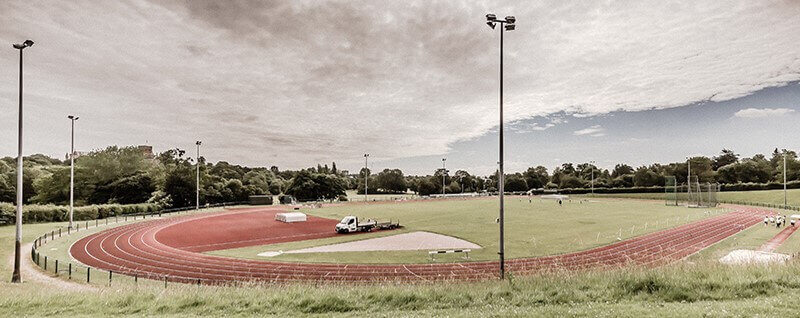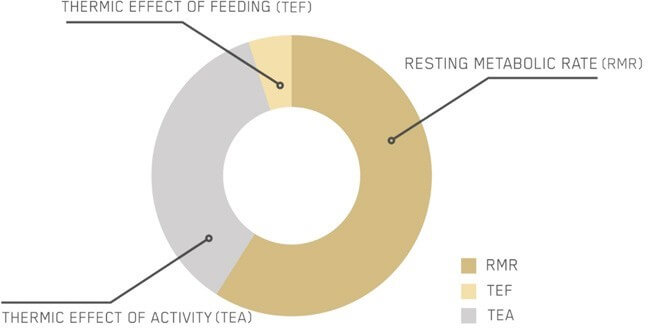Lets look at the ways in which we burn calories for health and weight loss.
Calories
All food and drink provide the body with energy in the form of calories (kcal)
- Protein and carbohydrates = 4 kcal/gram
- Fats = 9 kcal/gram
- Alcohol = 7 kcal/gram
Calculating Calories
To calculate calories from each macronutrient multiply the amount of the macronutrient within the food by the associated amount of calories:
- For example, if a food had 20 g of protein:
- 20 g x 4 kcal = 80 kcal from protein
How do we Burn Energy?
Your Daily Energy Requirements are dependent on:
- Body Size
- Daily Living
- Body Composition
- Energy Cost of Training
Energy Balance Occurs when the Daily Energy (Calories) Consumed Matches the Daily Energy Expended:
Total Daily Energy Expenditure (TDEE)
- Estimating Total Daily Energy Expenditure, which is the net caloric expenditure resulting from all metabolic processes and activity over 24 hours including:
- Sleep
- Rest
- Activity
- Thermogenesis
- Thermogenesis is the production of heat from certain processes, such as the metabolism of food
Total Daily Energy Expenditure Consist of 3 Components:
- Resting Metabolic Rate (RMR): Energy Required to Keep Your Body Functioning at Rest
- Thermic Effect of Activity (TEA): energy expended during planned exercise and all other planned or unplanned activity and includes a component known as Non-Exercise Activity Thermogenesis or NEAT which is the energy expended for every activity we do that is not sleeping, eating or planned exercise, some examples include; fidgeting, walking, laughing, gardening
- Thermic Effect of Feeding (TEF): Energy Expended Digesting Food
- Protein has the highest TEF with 20-30%
- Carbohydrates = 5-10% TEF
- Fat = 3-5%
Determinants of Energy Requirements
- Age
- Activity / Exercise Level
- Body Composition
- Stress
- Menstrual Cycle
- Environmental Temperature
- Fasting / Starvation
- Malnutrition
- Thyroxine
The government has set estimated guidelines for the general population who aim to maintain their body weight based on average activity levels.
An Example of Various Athlete’s Daily Energy Intake
- This graph gives a rough estimation of the calories required for various athletes to maintain their daily training & body weight
Calculating and Monitoring Energy Expenditure
Basal Metabolic rate (BMR)
- Basal Metabolic Rate (BMR) should be calculated using an individual’s:
- Body Weight
- Height
- Age
- Which are then inputted into a predictive equation for BMR, i.e. The Harris-Benedict equation
Physical Activity Level
Multiply BMR by the appropriate PALs will give a rough indication on an individual’s total daily energy expenditure (TDEE) to maintain weight.
Increase Energy Expenditure
- To increase energy expenditure:
- Increase daily activity levels (steps)
- Lifestyle habits
- Introduce training/structure exercise
- “Eat less, move more” is not useful to a client as it provides insufficient information/education
BMI
BMI Provides an Indirect Assessment of Healthy Weight According to an individual’s Height & Weight.
- BMI Equation: Weight (kg) / [Height (m)]2
The government recommendations for BMI are set out below:
Waist To Hip Ratio, (You can read more about this HERE)
- Abdominal Obesity is defined by the World Health Organisation (WHO) by a Waist : Hip Ratio of:
- Male: >0.9
- Female: >0.85
- BMI should be used in combination with waist circumference to provide an insight into the health status of individuals
- BMI may not give an accurate assessment for athletic populations as increased muscle mass will skew the results
What are the Health Risks with being Overweight?
Type 2 Diabetes
Increased BMI and Waist Circumference are associated with an Increased Risk of Type 2 Diabetes (T2D)
- Usually Late Onset
- 90% of Diabetes In UK is Type 2
- When Body Become Resistant to Insulin
- Lack of Control of Blood Glucose Levels
Risk Factors
- Age
- Caucasian and Over 40 yrs
- African-Caribbean, Black African, or South Asian, and Over 25 yrs
- Close Family Member has Type 2
- Other Constituents of Metabolic Syndrome
- Those with an obese BMI are 80 times more likely to develop T2D
- Although very unlikely, you can still develop T2D if you are lean
- Over the next 20 years, the number of obese adults in the UK is forecast to rise to 26 million, with over a million extra cases of T2D
Cardio Vascular Disease
- CVD is one of the Leading Causes of Death and Disability in Ireland and the UK
- Cardiovascular Disease is associated with:
- A Build-up of Fatty Deposits Inside the Arteries (Atherosclerosis)
- Increased Risk of Blood Clots
- There are 4 Main Types of the Disease:
- Coronary Heart Disease
- Stroke
- Peripheral Heart Disease
- Aortic Disease
If an individual is physically fit, it reduces their risk of CVD even with an obese BMI, as shown in the graph below:
Summary
- Total Daily Energy Expenditure (TDEE)= NET Caloric Daily Expenditure
- TDEE Consists of RMR, TEE and TEF
- TDEE can be Increased Through Simple Life Changes
- Risk of Disease (T2D & CVD) can be Monitored by BMI and Waist Circumstance












